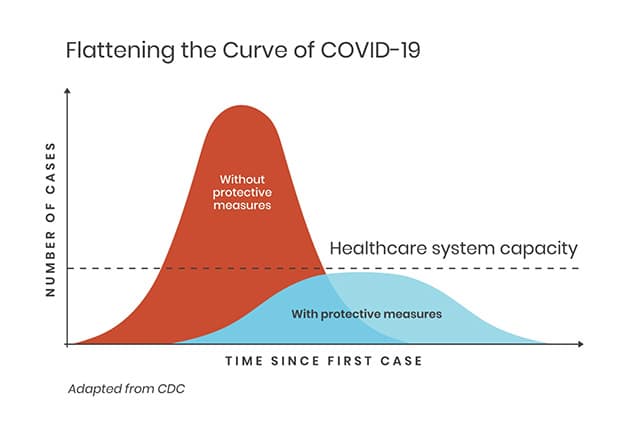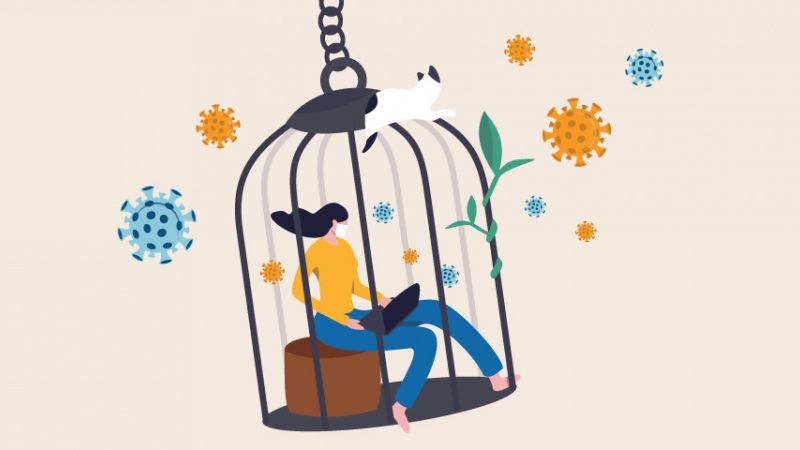If you’ve been paying attention to the news, you may have noticed a new term that seems to be trending: social distancing. There can be confusion around what this new term actually means, and how to apply it to your family and friends. Luckily, we have answers to some of the most common questions about social distancing, which can help you better protect yourself and your loved ones from COVID-19.
What Is Social Distancing?
The Centers for Disease Control (CDC) defines social distancing as “remaining out of congregate settings, avoiding mass gatherings, and maintaining distance (approximately 6 feet) from others when possible.” In layman terms, this means that the CDC is recommending that people do not congregate in groups larger than 10 people, and if you are outside of your home you must keep a safe distance of 6 feet between you and passersby.
It is for this reason that sporting events, conferences, concerts, and other densely populated events have been canceled in recent weeks. While it may be disappointing to be missing out on opportunities to experience life as you did before the coronavirus outbreak, Johns Hopkins Medicine explains that this kind of social distancing means “deliberately increasing the physical space between people to avoid spreading illness [because] staying at least six feet away from other people lessens your chances of catching COVID-19.”
What Does “Flatten The Curve” Mean?
Social distancing aims to flatten the curve, which is a reference to a scientific chart that shows how slowing the spread of the virus can prevent deaths by reducing the amount of people using the hospital systems at the same time. When more people are out and about living their lives (NOT social distancing), the chances of them contracting the virus are much higher, which also means the chances of them needing medical attention at the same time is higher. In other words, the longer it takes for the virus to spread across the population, the more time hospitals have to prepare for its arrival.

As we are seeing in New York City right now, the hospital systems are overwhelmed; doctors and nurses do not have enough protective gear, like masks and gloves, there is a shortage of ventilators, and a lack of beds for patients with COVID-19. New York was unable to slow the spread of the virus, but by social distancing, the rest of us can try to prevent our own communities from becoming the next New York City.
Are Social Distancing and Being Quarantined The Same Thing?
People are using these terms interchangeably, but there is a difference between social distancing and being quarantined. Social distancing is recommended for everyone to practice right now, whether you have symptoms of the virus or not. Being quarantined, on the other hand, is a self-imposed lockdown once you start to display symptoms of the virus or have come in contact with someone who has tested positive for the virus.
If you are practicing social distancing, you can still leave your house to exercise, walk your dog, and pick up essential items from the grocery store or pharmacy. Social distancing aims to lower your chances of coming into contact with someone with the virus. It has been shown, however, that people can be asymptomatic but still test positive for the virus, thus, spreading it around to others without knowing. For this reason, people who are socially distancing themselves are still encouraged to sanitize their hands regularly while out in public, wash your hands after coming into contact with anything from the outside world, and avoid touching your face as much as possible (unless your hands are freshly washed). Should you start to experience symptoms of the coronavirus, which typically includes a fever, a dry cough, shortness of breath, and fatigue, you should self-quarantine immediately so that you don’t infect others in your community.
Experts have recommended that the quarantine period last for at least 14 days, as it can sometimes take that long for symptoms to appear. If you are quarantined, please refrain from leaving the house at the end of the 14-day period if you are still feeling ill. If you are sick and can recover at home, the CDC guidelines recommend waiting until you’ve gone 72 hours without a fever (and at least 7 days from the appearance of symptoms), before leaving your house.
Can I See My Family While Socially Distancing?
The answer to this question is tricky, because it depends on a few factors. Of course, if you live with your family, you will be able to keep seeing them as you normally do. If you do not live in the same house as your family, however, there are a variety of situations that require different responses:
- Your loved one is in a nursing home or rehab facility. Unfortunately, most medical facilities across the country right now are on lockdown, as they are trying to prevent the spread of the virus within their facility. If you come to visit mom and are carrying the virus, you will most likely end up spreading it around the entire community, which poses a danger to everyone who resides and works there. Even though this can be challenging and disheartening for many family members, people around the country have been getting creative about how they can show their loved ones they care about them from a distance.
- You or your loved ones are not practicing social distancing. This is also a situation where it is not recommended to connect with family members who are not in your house. The virus has proved to be especially harmful to the health of those over the age of 60, so if you are not abiding by the social distancing recommendations, you run the risk of potentially passing the virus to an older loved one. And because the virus has been appearing more mild in young children, if your grandchildren have not been social distancing properly, they run the risk of passing the virus on to you without even knowing.
- You are both practicing social distancing and have limited your exposure to the virus. In this case, it is okay to essentially socially distance together. If, for example, you and your loved one have both been socially distancing yourselves for at least 14 days and have not presented any symptoms of COVID-19, you can agree to see one another, or to essentially practice social distancing together as one family unit. In order for this to work, however, both parties must agree to strictly abide by the rules so as not to create a vulnerability for the virus to penetrate the extended family.
Can I Still Catch The Coronavirus While Socially Distancing?
Unfortunately, the answer is yes; you can still potentially catch the virus even while you are socially distancing yourself. The CDC recommends the following guidelines to reduce your overall risk of contracting the virus:
- Wash your hands often. Ideally, you should wash your hands with soap for at least 20 seconds, “especially after you have been in a public place, or after blowing your nose, coughing, or sneezing.”
- If you can’t wash, sanitize. If you are out in public (like the grocery store or pharmacy), take hand sanitizer with you. Be sure that the sanitizer consists of at least 60% alcohol for efficacy. Cover all surfaces of your hand with the sanitizer and rub together until dry.
- Avoid touching your eyes, nose, and mouth with unwashed hands. These are the main points of entry for the virus.
- Avoid close contact with people who are sick. While it’s typically a nice gesture to bring your neighbor soup if they are not feeling well, it’s better to keep your distance with the coronavirus, as it spreads easily.
Check the Medical Guardian website regularly for more coronavirus information, articles and helpful checklists.

